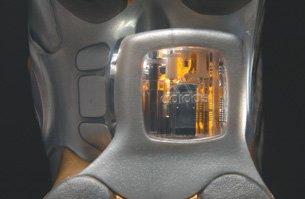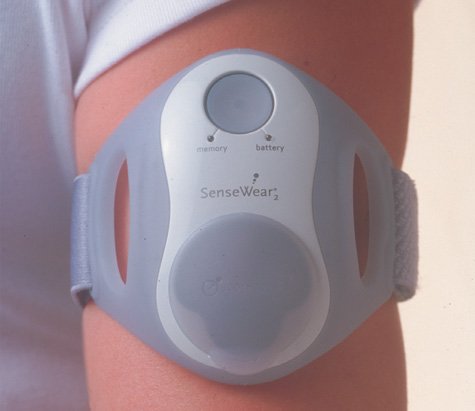Wearables
| The next computer you own might be a size 10. Although the idea of wearable computing has been around since the early 1960s, it wasn't until 2005, when Adidas introduced Adidas_1 (Figure 9.6), a running shoe with a microprocessor in it that adjusts the cushioning of the shoe based on its use, that the idea of wearables reached the public consciousness. Likely, Adidas succeeded because the Adidas_1 looks stylish, unlike many previous attempts at wearables: clunky pieces of gear awkwardly strapped to some geek's body. Figure 9.6. The Adidas_1 shoe has a magnetic sensor in the heel that senses the level of compression. This compression level is sent to a microprocessor in the shoe that adjusts the cushioning via a motor-driven cable system, making the shoe softer or firmer as needed.
Designers of wearables take as their starting point the fact that the thing most people have with them most of the time is their clothes. Why not, then, use clothing as a platform for technology so that we have things that we need with us all the time? Computers in clothing can adjust the clothing to project messages, react to other devices, or change according to the weather or the wearer's mood (Figure 9.7). Of course, wearables don't have to be clothing per se. BodyMedia's SenseWear products (Figure 9.8) are small devices that strap on an arm and monitor the wearer's health. Wrist-watches have been a basis for wearables, such as Fossil's WristPDA. Figure 9.7. F+R Hugs ("The Hug Shirt") created by CuteCircuit is a shirt that allows people to send and receive the physical sensation of a hug over long distances. Embedded in the shirt are sensors that feel the hug's strength, the skin's warmth, and the heartbeat rate of the sender. Actuators re-create those sensations in the shirt of the distant loved one.
courtesy of CuteCircuit Figure 9.8. BodyMedia's SenseWear armband, worn on the back of the upper-right arm, uses a multisensor array to collect continuous physiological data directly from the wearer's skin. Users can monitor their energy expenditure (calories burned), duration of physical activity, number of steps taken, sleep/wake states, and more.
courtesy of BodyMedia The challenges for interaction designers working with wearables are many, as are the opportunities. Designers have to pay particular attention not only to functionality, but also to form. Wearables, unlike devices that sit on a desk or slip into a pocket or purse, are meant to be, well, worn. And things worn on the body for long periods of time need to be durable, stylish, and unobtrusive. Their context is anywhere that humans are, and that is an extremely broad and varied set of environments. The opportunity with wearables is in the fact that people don't need to be concerned about "another device to carry." Users won't have to carry anything except the clothes they wear or something strapped to their bodies like a fashion accessory. Information and functionality move with the user, available when needed, and data is captured from the user's body and location that might never be captured otherwise. Wearables also allow interaction designers to take advantage of more parts of the body than they are used to engaging. A glove with sensors might unlock doors with a flick of a finger. A sleeve might become a screen for projecting images, and a necklace, like Microsoft Research's proposed SenseCam, might take thousands of pictures a day, allowing users to replay their days visually if they choose. |
EAN: 2147483647
Pages: 110


